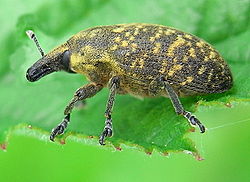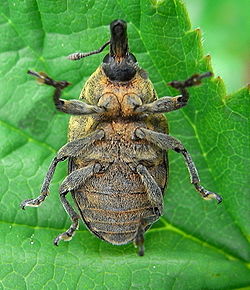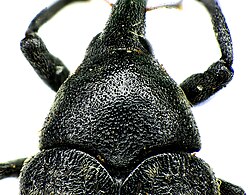Thistle weevil
| Thistle weevil | ||||||||||||
|---|---|---|---|---|---|---|---|---|---|---|---|---|

Fig. 1: Thistle weevil ( Larinus turbinatus ) |
||||||||||||
| Systematics | ||||||||||||
|
||||||||||||
| Scientific name | ||||||||||||
| Larinus turbinatus | ||||||||||||
| ( Gyllenhal , 1835) |
The sea thistle weevil ( Larinus turbinatus ) is a beetle from the family of weevils and the subfamily Lixinae . Contrary to what its German name suggests, it does not only develop in thistle species , but also uses a wide range of thistle-like plants as host plants . It can be distinguished from its close relatives by the shape of its trunk.
The species is listed in the red lists of North Rhine-Westphalia under category 2 (rare species that are bound to certain biotopes, endangered to be assumed). In Rhineland-Palatinate , it is considered threatened with extinction.
The species name turbinātus is Latin , means "cone-shaped" and refers to the shape of the trunk. The generic name Larínus (from ancient Greek λαρίνος larínos, "feist") alludes to the rounded body shape.
In Europe the genus Larinus is represented with around sixty species. The sea thistle weevil belongs to the subgenus Phyllonomeus .
Characteristics of the beetle
The round proboscis, the furrow of which runs backwards and downwards to insert the first antennae, and ends far in front of the eyes on the underside of the proboscis, places the beetle in the subfamily Lixinae. The genus Larinus is characterized by a squat oval shape and the medium length of the trunk. Furthermore, the antennae are pivoted in the front third of the trunk and the antennae pit is not extended to the front.
The species L. turbinatus differs from the other species of the genus by its trunk shape. The trunk is round and somewhat shorter than the pronotum. Viewed from above, it hardly tapers towards the front; a central keel is at most indicated. In side view, the trunk is hardly curved downwards and tapers in a conical manner (Fig. 2). On the underside of the trunk has a longitudinal furrow that is angularly offset towards the trunk side. The proboscis furrow ends diagonally in front of and under the eyes in this longitudinal furrow (Fig. 3).
Like the other Central European species of the genus, the beetle is black, the wing-coverts are irregularly speckled with transverse gray patches of hair. These hair patches generally appear with a yellowish secretion and adherent pollen but yellow. The elytra are about one and a half times as long as they are wide, the ends rounded together. The dotted stripes of the elytra are fine and not deepened.
The pronotum (Fig. 4) is wider than it is long: towards the front it is bell-shaped to a little more than the width of the head. Its base is pulled forward to the label . It is sculptured with coarse and with fine points moderately dense ( double-dotted ).
biology
The warmth-loving species occurs mainly on open, warm slopes, fallow vineyards and steppe heath, where thistles also occur.
The sea thistle weevil belongs to the group of Larinus species that attack open flower heads for egg-laying. These species have duller proboscis because they do not have to bite through the bud shell. An egg channel is drilled into the flower head with the trunk from above and the eggs are pushed into the flower head over this. The larvae feed on the ovaries of the individual flowers and on the tissue of the basket floor . The females avoid laying eggs in flower baskets that were already occupied by Larinus planus during the budding stage.
A female covers the flower with an egg and then goes to an adjacent flower. Since a female lays at least five to six eggs per day and several females can often be seen laying eggs on the same host plant, multiple occupancy of the same flower is not unlikely. Several larvae are often found in the same flower. In the experiment it was observed that the stronger larva drives away, pursues and kills the weaker larva as soon as the two duct systems come into contact with one another. In the last larval stage, there is usually only one larva per flower.
Pupation also takes place in the thistle blossom, which has now faded.
The beetles are diurnal and also feed on thistles, and occasionally on other composite plants.
Distribution and occurrence
The species is distributed from Turkestan and the Caucasus over all of southern Europe and southern central Europe. Within Germany , it occurs to the north in the southern Rhineland , in the Middle Elbe region and in Thuringia . It is rare here in general.
The species was accidentally introduced into North America and is now represented in Pennsylvania and Maryland.
literature
- Heinz joy , Karl Wilhelm Harde , Gustav Adolf Lohse (ed.): The beetles of Central Europe . tape 11 . Rhynchophora (end). Goecke & Evers, Krefeld 1983, ISBN 3-87263-031-8 .
- Klaus Koch : The Beetles of Central Europe . Ed .: Heinz Freude . tape 3 : ecology . Goecke & Evers, Krefeld 1992, ISBN 3-87263-042-3 , pp. 246 .
Individual evidence
- ↑ a b Taxonomy, synonyms and distribution for Larinus turbinatus
- ↑ Red lists at BioNetworkX
- ↑ Sigmund Schenkling: Explanation of the scientific beetle names (species)
- ↑ Sigmund Schenkling: Explanation of the scientific beetle names (genus)
- ↑ Larinus at Fauna Europaea. Retrieved March 13, 2013
- ↑ Larinus Cryphopus (subgenus) in Fauna Europaea. Retrieved March 13, 2013
- ↑ Larinomesius (subgenus) in Fauna Europaea. Retrieved March 13, 2013
- ↑ Larinus Larinus (subgenus) in Fauna Europaea. Retrieved March 13, 2013
- ↑ Larinus Phyllonomeus (subgenus) in Fauna Europaea. Retrieved March 13, 2013
- ↑ H. Zwölfer, R. Brandl Niches and size relationships in Coleoptera associated with Carduaeae host plants: adaptations to resource gradients. In: Oecologia. Volume 78, No. 1, January 1989, p. 6068, DOI: 10.1007 / BF00377198
- ^ H. Zwölfer, B. Stadler: The organization of phytophagous guilds in Cardueae flower heads: conclusions from null models. In: Evolutionary Ecology Research, 2004, 6. pp. 1201-1218 as a PDF file. ( Page no longer available , search in web archives ) Info: The link was automatically marked as defective. Please check the link according to the instructions and then remove this notice.
- ↑ Etienne Rabaud: VI. "L'Instinct de l'isolement" chez les Insectes. In: L'Année psychologique. Volume 19, No. 19, 1912, pp. 194-217 as a PDF file.
- ↑ L. Gültekin: A new weevil species Larinus araxicola sp. n. (Coleoptera: Curculionidae: Lixinae) from northeastern Turkey with biological notes. In: Proceedings of the Russian Entomological Society. Volume 77, St. Petersburg, 2006. pp. 44-47, PDF file. ( Memento of the original from October 31, 2008 in the Internet Archive ) Info: The archive link was inserted automatically and has not yet been checked. Please check the original and archive link according to the instructions and then remove this notice.
- ↑ Larinus turbinatus . bugguide.net. Retrieved January 5, 2020.


